
Exhibitions: Current | Upcoming | Past
Exhibitions: Past
50 Years
Leading | Teaching | Learning
Works by Marion Wilner, Ron Lister, Marisa Millard, and Erik Durant
October 29 – December 10, 2015
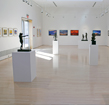
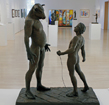

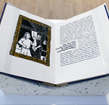
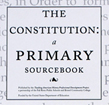



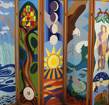
As part of the 50th anniversary celebration at BCC, the gallery is delighted to showcase the work of Marion Wilner, Ron Lister, Marisa Millard, and Erik Durant.
We honor and celebrate these artist-teachers who have shaped the Art and Design Programs at BCC. They are united by their devotion to teaching, as well as their commitment to program development. Marion Wilner laid the foundations in 1966 when she was appointed as the first full-time faculty member of the newly formed art program. As President Emeritus Eileen Farley observed about those early days, "Marion led us to recognize that artistic interests and talents were to be found across the spectrum of social and economic class and that BCC's mission could and should accommodate these interests and talents."
From a curriculum that, in its nascence, included primarily art history courses, the programs today encompass a breadth of offerings across the range of fine art and design disciplines. The programs continue to evolve in anticipation of the rapidly changing work environments our students will be entering. Focused areas of study provide essential learning opportunities that prepare them for jobs right out of college or to transfer and complete their degrees at a 4-year college or university.
The strength and vibrancy of our art and design programs are also evidenced in the sense of community and family. Through a combined effort of spirit and commitment, our program coordinators establish and oversee a nurturing environment that is simultaneously conducive to the rigor and discipline of learning, and of awakening, expanding, and focusing the creative spark in our students.
Teaching is not an easy profession. One cannot make another learn something. But to instill in another the value of seeking something, the importance of effort, in part, comes from our common interests and shared passions about what we do. To become fluent with this thing we call visual language is a difficult exercise fraught with many challenges, but also many rewards along the way.
When Marion Wilner was appointed to the faculty, art was not a high priority in the curriculum. Through her hard work and enduring vision of a rigorous foundation of study for young artists, the Art Transfer Program was officially recognized in 1980.
In 1981 Ron Lister came on board as an adjunct instructor. He took on the role of program coordinator of the Art Transfer Program in 1989. In addition to continuing the work of expanding and developing the art program, and increasing contact time for studio courses, Ron worked to grow the arts curricula to include a design program.
Marisa Millard joined the BCC family in 1998-97 first as an adjunct instructor and then as a full-time member of the community with a mandate to shape a design program. A reflection of her ongoing work and vision, the area continues to evolve to prepare young designers as they enter the work force.
Erik Durant began his career at BCC as an adjunct instructor 2005, and was then hired as a full time professor and program coordinator in 2008. He and Marisa continue to build, expand, and shape vibrant and rigorous Art and Design Programs at BCC.
Kathleen Hancock
Director
Artists
Marion Wilner
I am home again, in this gallery space I dreamed of, desired, planned for, and finally, helped to make come true. Fifty years ago I signed on to the BCC mission at the moment of its birth. That decision made my life and my work inseparable. While I taught my students what making art was about I learned how to expand the mind and heart. Teaching has been a two-sided coin. One side reflects my desire to instruct, to share knowledge and experience with the students, while the other rewards me with the depth and variety of student response. Encouraging each student's individual growth sustained and inspired my own. Teaching at BCC was a wonderful way of life. I am fortunate to remain in contact with and remembered by students who found learning about art exciting and fun. Together we opened the door to a new world. Today, many just enjoy museums; others paint as a hobby, and a growing number are professional working artists. Creativity is rooted in the urge to make connections, to touch the past and define the present. Nature has been my touchstone and drawing has been my passion. The search for continuity led me to incorporate classical myths and biblical narrative into my figurative work. The human body speaks to me of strength and spirit. I grew up between the twilight of Cezanne and the sunrise of abstract Expressionism. My work seeks to combine the freedom of painterly gestures with control and the preservation of the image. I enjoy experimenting with a variety of media as I explore new directions. Printmaking has given me great pleasure and many surprises. For an artist every day is a new beginning. I want to thank my friends, my colleagues and especially my family for enhancing those beginnings with understanding and appreciation.
Ron Lister
For over 30 years I have been blessed with the opportunity to teach, mentor, and help guide students. I believe that although a career in art can be highly competitive and tough, the rewards are numerous. To create art and bring ideas to life are special achievements that are worth all the uncertainty and failures that come with the territory. As an art teacher, I teach the fundamentals of painting and drawing, but of equal importance?to me is nurturing the creative spark we all have in us. I realize too that not all of my students will make it as artists and so I feel that teaching some basic philosophy of life is also of worth the effort. I tell my students that technique and style are important, but having something to say (communicate) is ultimately the most important piece to the puzzle. For many years now, the response of my students has simply amazed me. I am grateful to them all.
Marisa Millard
Because communication is so fundamental to graphic design, my teaching approach centers around giving students the tools to generate creative ideas to solve a given problem. My goal is for students to become independent thinkers, able to effectively express their ideas through the visual language. Good visual solutions can affect perceptions, re-contextualize information, influence public awareness and persuade. I emphasize to students that graphic designers should be passionately committed to their work and vision. To help students translate concepts into visual terms, I introduce various theories of visual perception, semiotics and rhetoric. Although my approach to teaching theory is pragmatic, using theoretical terminology offers a common language, which allows for more precise discussions of the work. During critiques, I encourage students to verbally articulate what's going on in their work; in the evaluation stage of the design process, students develop analytical skills through written evaluations of their own and other's work. This way they can objectively assess a project's strengths and weaknesses, and use that knowledge for the next project. My responsibilities as an educator extend beyond the classroom; I maintain a professional practice, using new media and technology, focusing on web design. My pedagogical research continues to focus on theories of visual perception and semiotics that can be applied to visual communication, as well as how to more effectively use the critique process in classes. I am constantly seeking ways to refine and improve my teaching skills in order to motivate and inform students.
Erik Durant
I conceptualize my students as young artists. I believe that an art teacher's role is to give these young artists the skills they need for a career in the intensely competitive field of art. This begins in school by developing a strong foundation. A successful young artist needs three main things: appropriate technical skills, a strong portfolio, and the ability to successfully write about artwork. As a teacher, I bring all three of these into the classroom. I firmly believe that observational drawing is the foundation for all of art students regardless of media. For young artists, learning to draw is really about learning to see. Students must learn how to accurately represent what they see in front of them in order to accurately represent what they see in their minds. Competency in drawing inevitably leads to the development of good technical abilities in other areas of the visual arts. Young artists will be required to demonstrate these acquired abilities in order to break into the art world. To this end I construct my projects towards making finished portfolio pieces that are professional and ready to be exhibited. For artists, it is the portfolio that opens doors. Art students need to be in the habit of treating their work as if it is for display from the beginning. The portfolio gives students the ability to demonstrate that they have the skills that their transcripts describe. In addition to making artwork, students need to be able to articulate the motivation behind their creativity. I believe that encouraging students to begin writing about their own art early on better prepares them for the future when they will be required to write proposals for commissions, statements for galleries, or reports for clients. The combination of a strong portfolio that demonstrates good technical skills, and the ability to articulate in writing the motivation behind the work, will allow any young artist to succeed beyond their academic training.

